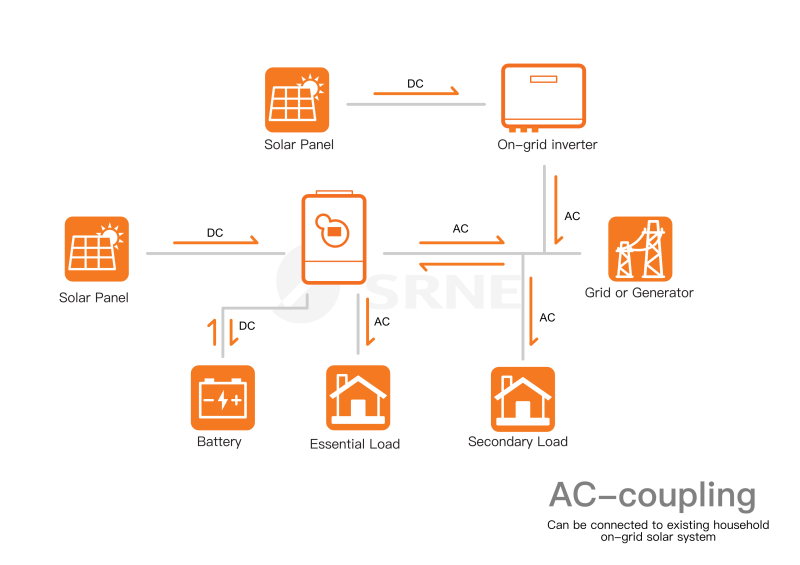AC Coupling and DC Coupling
AC coupling is a coupling method that transfers AC signals. In energy storage systems, AC coupling is typically achieved through the use of capacitors. It allows AC signals to be transmitted within the system while blocking DC signals. This coupling method finds extensive application in renewable energy systems such as solar and wind power generation systems. Through AC coupling, these systems can transmit AC electrical energy to storage devices for later use. AC coupling also offers advantages in reducing voltage offset and current drift, thereby improving system stability and efficiency.
The following figure is a schematic diagram of the inverter for AC coupling application. The grid-connected inverter and the off-grid inverter converge on the AC side, so it is called "AC coupling"
On the other hand, DC coupling is a coupling method that transfers DC signals. In energy storage, DC coupling is often accomplished using a combination of resistors and capacitors. Unlike AC coupling, DC coupling can transmit both DC and AC signals. This versatility makes DC coupling more adaptable to a wider range of applications in energy storage systems. DC coupling is commonly used to connect solar photovoltaic systems and energy storage systems for the transmission of DC power and stable storage and distribution of electrical energy. Furthermore, DC coupling finds broad application in areas such as electric vehicle charging stations and DC microgrids.
Understanding the concepts of AC coupling and DC coupling is critical in the energy storage industry, as these coupling methods provide essential support for the design and operation of energy systems. When selecting the appropriate coupling method, system requirements, application scenarios, and circuit design considerations must be taken into account. A comprehensive understanding of AC coupling and DC coupling principles and applications enables us to optimize the performance and efficiency of energy storage systems.
In conclusion, AC coupling and DC coupling are two vital concepts in the field of energy storage. AC coupling enables energy transmission and storage through the transfer of AC signals, while DC coupling allows the transmission of both DC and AC signals, providing greater flexibility in various applications. A deep understanding of these coupling methods will contribute to the effective utilization of energy storage products and drive the advancement and innovation of energy storage technologies.




































































































